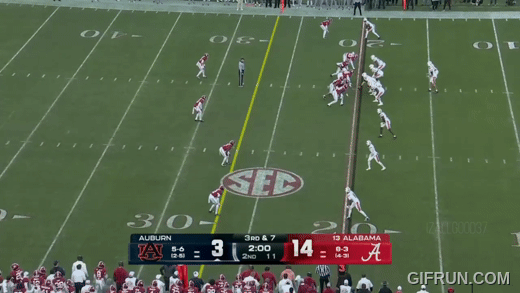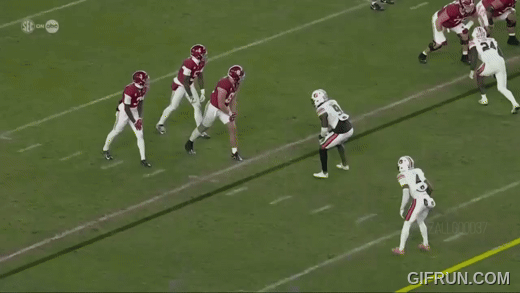TUSCALOOSA, Ala. — It was the biggest question all week: Which Alabama team would show up against Auburn? The dominant team that has flashed at times this season or the flat team that’s prone to maddening losses, like Oklahoma last week.
The answer was somewhere in between in its 28-14 win in the Iron Bowl, but the important thing is that Alabama extended its winning streak over the Tigers to five straight. Then, a few upsets opened the door just a little bit more for a possible College Football Playoff bid.
“It’s not this crazy party going on (in the locker room),” coach Kalen DeBoer said. “It’s a lot of just love and care for each other and smiles. That’s what it’s all about — coming together each and every week, the ups and downs. It’s been a great ride in a lot of ways. Obviously, there’s times when you’d love to have a few things go a little bit better.”
DeBoer’s sentiments summarized Alabama’s season and the game on Saturday. Alabama and Auburn were the teams they’ve been all season. Alabama had great moments and really bad moments, but its talent prevailed as it mostly has this season. Auburn played a good game on paper (25 first downs on offense, four forced turnovers on defense), but bad situational football and turnovers offset the good statistics.
The Pulse Newsletter
Free, daily sports updates direct to your inbox.
Free, daily sports updates direct to your inbox.
Sign Up
Now, it’s a waiting game for Alabama to find out its postseason fate. The final Alabama film study of the regular season is here. This week’s edition breaks down the good and the bad from Saturday, and there was plenty of both, which has been the story of this season.
Good: The running game
The absence of the running game against Oklahoma (70 yards) was a catalyst in the 24-3 loss. Outside of that game, here’s how Alabama finished the season on the ground: Missouri (271 yards), LSU (311), Mercer (189) and Auburn (201). The result on Saturday was a 13-minute advantage in time of possession and mostly manageable third downs (Alabama converted 12 of 18 tries).

Alabama’s defense held Auburn running back Jarquez Hunter (27) to 56 yards rushing on Saturday. (Jake Crandall / USA Today Network via Imagn Images)
The most pleasant surprise was the intent to get Jam Miller the ball. The junior running back carried a career-high 28 times for 84 yards. That’s not eye-popping yardage, but 25 of Miller’s 28 carries went for positive yardage, and within the flow of the game, he had some important moments.
This run on first down set up the game’s first touchdown. Kadyn Proctor and Danny Lewis did a good job on the edge, and Miller showed some athleticism by making the defender miss and popping a 14-yard gain.

Jalen Milroe got back into the ground attack with 17 carries for 104 yards and three touchdowns. Unlike last week at Oklahoma, the offensive line played much more in sync in the running game assignment-wise and got a consistent push. This play design was a good one by offensive coordinator Nick Sheridan with misdirection to throw off the defense, good blocks on the perimeter and Milroe outrunning the defense for the score. Milroe’s 20 rushing touchdowns this year puts him in a rare class of SEC quarterbacks to do that: Johnny Manziel, Cam Newton and Tim Tebow.

Bad: Ball security
This has been a rough spot the past two weeks. There have been seven turnovers, and Milroe has been responsible for six of them (three interceptions, three fumbles). What hurt the most about the four turnovers against Auburn was that each came at a moment when Alabama could’ve broken open the game. Here’s a first-half example:
Alabama scored a touchdown on the drive before, forced a three-and-out and got the ball back with a chance to score again before halftime. But on the first play of the series, Proctor got beaten badly off the edge. Milroe never felt the pressure, and the result was a strip-sack. Auburn turned this mistake into a field goal before halftime.

GO DEEPER
Does Alabama have a Playoff case after beating Auburn? Key Iron Bowl takeaways
The ball-security miscues included a Ryan Williams fumble on the game’s first possession, him dropping a touchdown pass and CJ Dippre dropping a touchdown pass in the first half.

Good: Defense set the tone
There was a lot of good by Alabama’s defense, mainly the fact that it allowed only six points off the four turnovers. What led to that success? The Tide forced Auburn into long yardage situations by playing well on first and second down.
Auburn running back Jarquez Hunter led the SEC in yards per carry (6.4) entering the game. Auburn did not have a run longer than 10 yards after the first quarter. Hunter was held to his second-lowest rushing total of the year (56 yards), and it was due to a physical effort by the defensive front.

GO DEEPER
Alabama’s Playoff fate is out of its hands. How should Kalen DeBoer’s debut be judged?
This play came at a critical time: Auburn was attempting to drive and take an early lead. Qua Russaw manhandled his assignment and made the tackle. Auburn then missed a field goal.
Overall, Auburn’s average third-down distance was 7.9 yards, and it converted only 4 of 12 attempts.

My prediction piece before the game emphasized that Alabama had to earn the right to rush the passer by playing well on early downs. That manifested itself Saturday with strong results. This key third down was an all-out blitz by defensive coordinator Kane Wommack. Auburn’s Payton Thorne was forced to get the ball out quickly, and Malachi Moore delivered a big hit to force the incompletion.

Alabama disguised this pressure. It looked like the one above, but this time, two defenders dropped into coverage and Moore blitzed from the secondary. Thorne rolled right into the pressure, resulting in an incompletion.

Bad: Explosive plays allowed
Most of Auburn’s total yards (281 of 399) were from pass plays of 15-plus yards and runs of 10-plus yards. Alabama’s defense stood up when it needed to, but allowing so many chunk plays (14 total) made the game tougher than it needed to be.
Once again, open-field tackling was Alabama’s nemesis. On this play, a potential second-and-short became an explosive play when DeVonta Smith missed the tackle and Auburn’s KeAndre Lambert-Smith turned upfield for a good gain.

Following a Milroe fumble in the fourth quarter, Auburn got into scoring position with another pass to Lambert-Smith when he made a defender miss and turned it into an explosive play.

But a few plays later, Bray Hubbard intercepted Thorne and shifted the game back to Alabama’s favor.
Good: Bernard
This route by Bernard came at an important moment. It was third-and-5 with Alabama leading 28-14 midway through the fourth quarter and trying to burn the clock. Bernard ran a beautiful route, keeping the defensive back guessing until he broke out for a 10-yard gain.

On the very next play, Bernard made a nice block on the perimeter to spring Dippre for an explosive gain and more time off the clock. That two-play snapshot is who Bernard has been all season.

He finished with a career-high 111 yards on seven catches. He’s not the flashiest player on the team, but Bernard has been one of the most reliable in nearly all aspects. On Saturday, three of his seven catches were on third down. He has been a nice security blanket all season and finished the regular season with 46 catches for 714 yards and two touchdowns.
He and Williams will make a strong 1-2 punch next season.
(Top photo of Jaeden Roberts: Jason Clark / Getty Images)
Source link : http://www.bing.com/news/apiclick.aspx?ref=FexRss&aid=&tid=674e463fbb9a4d71a7e0b0c14a6aba82&url=https%3A%2F%2Fwww.nytimes.com%2Fathletic%2F5961159%2F2024%2F12%2F02%2Falabama-auburn-iron-bowl-film-analysis%2F&c=9702496784547716684&mkt=en-us
Author :
Publish date : 2024-12-01 21:45:00
Copyright for syndicated content belongs to the linked Source.








